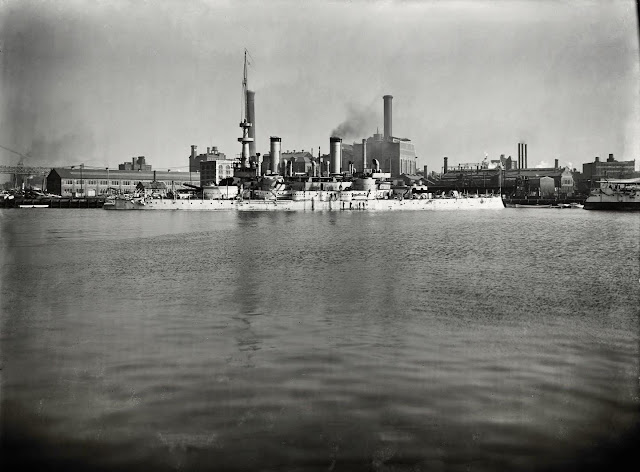 |
| USS Indiana (BB-1) |
US battleship Indiana (BB-1) at the New York Navy Yard around the turn of the 19th century. Though lacking instability due to fitting far too much into a limited displacement, the Indiana class managed to incrementally improve on the many shortcomings of the foreign-designed USS Texas, the USN’s first battleship, which was obsolete when launched and never received a hull designation during the retroactive nomenclature standardization of 1920.
-
Naming ships is frequently much more complex than one would think. The United States did not adopt the prefix “USS” officially until 1909 - similarly, they did not begin using type designations until 1895. When type designations began, the navy was expanding; this led to a need for designating vessels with a type and a hull number, so Indiana as the first authorized battleship under these rules became “Battleship 1.” Often these were abbreviated to “B-1” while cruisers and destroyers used C and D with their hull number respectively. After WWI, with the addition of a multitude of auxiliary types, the nomenclature was standardized as two letters; the first letter represented the overall type, while the second represented subclass. Thus, C for a cruiser, L for a light cruiser, etc. Battleships and destroyers did not have a subclass, thus the first number was duplicated.
-
Other navies did not mirror the practice. In fact, most navies internationally in the first half of the 20th century did not even adopt national prefixes; for this reason, many of the errant shorthand prefixes applied to French, German, Russian, and Japanese warships never existed. Germany did use the “SMS” prefix during the Imperial years, but nothing thereafter. Austria-Hungary, Argentina, and Britain also used national prefixes, as notable examples. Dutch, Swedish, and Norwegian prefixes are usually anglicized to include a national identifier to their basic “His/Her Majesty’s Ship,” already in English use. Most prefixes seen in literature for the period are simply western authors adding in an Anglican acronym for “clarity” and uniformity, which is a shorthand route away from fact and has led to serious confusion over proper naming conventions.
-
 |
| USS Winconsin (BB-64) The last completed Battleship to enter service with the US Navy |


No comments:
Post a Comment